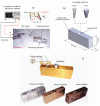Evaluation of a Piezo-Actuated Sensor for Monitoring Elastic Variations of Its Support with Impedance-Based Measurements
- PMID: 30621038
- PMCID: PMC6339132
- DOI: 10.3390/s19010184
Evaluation of a Piezo-Actuated Sensor for Monitoring Elastic Variations of Its Support with Impedance-Based Measurements
Abstract
This study exposes the assessment of a piezo-actuated sensor for monitoring elastic variations (change in Young's modulus) of a host structure in which it is attached. The host structure is monitored through a coupling interface connected to the piezo-actuated device. Two coupling interfaces were considered (an aluminum cone and a human tooth) for the experimental tests. Three different materials (aluminum, bronze and steel) were prepared to emulate the elastic changes in the support, keeping the geometry as a fixed parameter. The piezo device was characterized from velocity frequency response functions in pursuance to understand how vibration modes stimulate the electrical resistance through electrical resonance peaks of the sensor. An impedance-based analysis (1⁻20 kHz) was performed to correlate elastic variations with indexes based on root mean square deviation (RMSD) for two observation windows (9.3 to 9.7 kHz and 11.1 to 11.5 kHz). Results show that imposed elastic variations were detected and quantified with the electrical resistance measurements. Moreover, it was demonstrated that the sensitivity of the device was influenced by the type of coupling interface since the cone was more sensitive than the tooth in both observation windows. As a final consideration, results suggest that bio-structures (fruits and bone, among others) could be studied since these can modify naturally its elastic properties.
Keywords: bio-monitoring; elastic variations; electromechanical impedance technique; piezo-actuated sensor; structural health monitoring; vibration through teeth.
Conflict of interest statement
The authors declare no conflict of interest.
Figures









References
-
- Li H.N., Ren L., Jia Z.G., Yi T.H., Li D.S. State-of-the-art in structural health monitoring of large and complex civil infrastructures. J. Civ. Struct. Health Monit. 2016;6:3–16. doi: 10.1007/s13349-015-0108-9. - DOI
-
- Martinez-Luengo M., Kolios A., Wang L. Structural health monitoring of offshore wind turbines: A review through the Statistical Pattern Recognition Paradigm. Renew. Sustain. Energy Rev. 2016;64:91–105. doi: 10.1016/j.rser.2016.05.085. - DOI
Grants and funding
LinkOut - more resources
Full Text Sources
Research Materials

